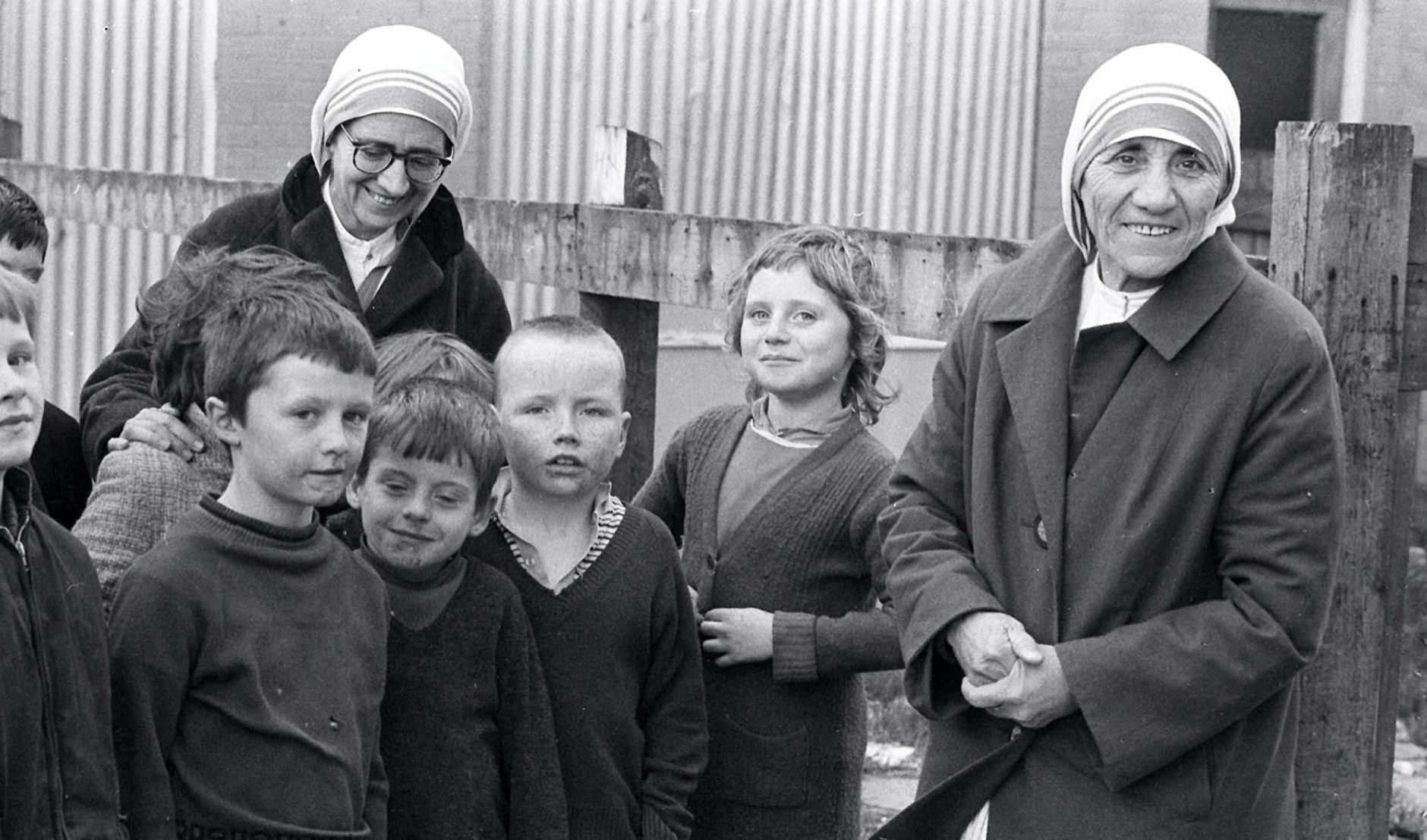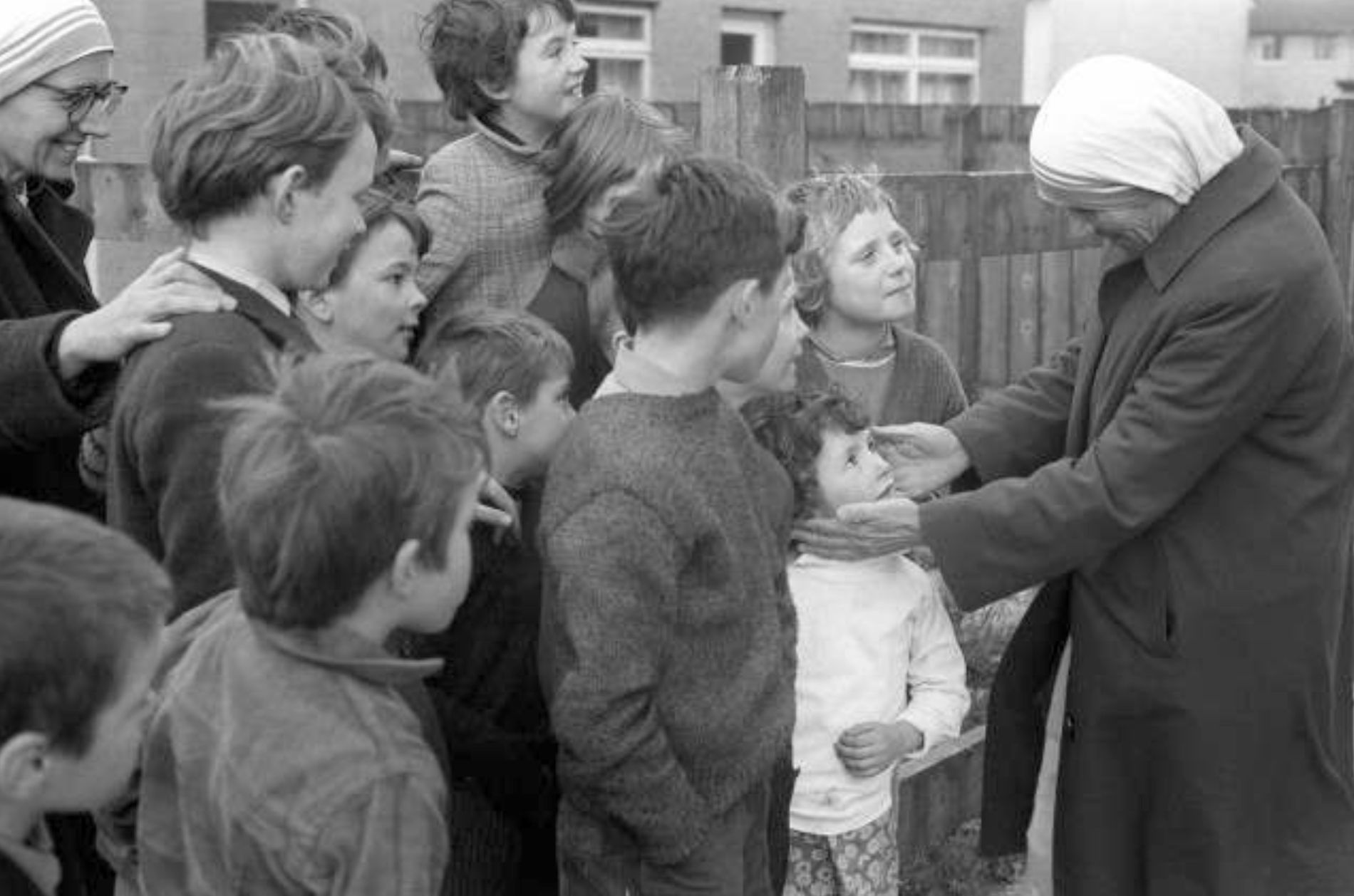THE Andersonstown News was born as a voice for the voiceless in November 1972. A community response to the suffocating repression of civil rights, brought to a head by internment without trial, this paper challenged the official propaganda peddled by the mainstream media and breached the wall of silence built around state abuse and injustice of the men and women 'behind the wire'. PODCAST: In the first episode of Over The Wire, we spoke to Ciaran Cahill about Mother Teresa's time in West Belfast Mother Teresa at Springhill House
This year, as we mark 50 years of speaking truth to power, we continue to provide a voice for the community champions who have been drum majors for justice for two generation and counting. And we are doing so in these changing times with changing modes of communication - switching print for podcast.
We hope you enjoy our new 'Over The Wire' podcast by our reporter James McCarthy featuring some of the unsung heroes of this past half-century.
In our first episode, we were joined by Ciaran Cahill from Springhill Community House, an organisation which is also celebrating its golden anniversary this year, to discuss one of our most memorable headlines from the early days – Nuns fired by Canon.
This story looked at how Mother Teresa and the Sisters of Charity were forced to leave the area by Canon Murphy and through this podcast episode, Ciaran reflected on how they came to live in the area, their dismissal and the legacy that Mother Teresa and her nuns have left behind.
“It was all done Father Des [Wilson],” he said.
“He was doing a lot of work, you know, speaking to different faiths, and he had a Methodist minister who was based in London, Roger Grieves, and he met Mother Teresa when he was in London.
“Mother Teresa had said to him that she wanted to set up a house here in Belfast, possibly along an interface or a peace line, obviously, we were going through a very difficult time with conflict. So he spoke to Des as about that.
“Des feared, really, that setting up a house with Mother Teresa, on the peace line would give the wrong idea that it was a conflict between Catholic and Protestants rather than, both bad government and inequality.
“So he said, really the thing to do is the invite her to Ballymurphy, and for her to decide herself. So that invitation went out and she came to Ballymurphy on the second of October 1971.
“Father Des said mass at 10:30 the next morning in Corpus Christi Parish, and he announced that Mother Teresa was there. She received a standing ovation, which would have been unusual in 1971.
“As soon as mass was over, really, the congregation, the community here in Springhill and Ballymurphy just embraced her. And Des said that she just disappeared for a period of time.”

Ciaran said that the people of Ballymurphy took Mother Teresa into their homes, and then eventually, she came back out and she decided that she wanted to set up a house in the area and she sought the proper permission.
“She went to the bishop, Bishop Philbin at the time, and he gave her his blessing that she could do that within the community,” Ciaran continued.
“So the house there 119 Springhill Avenue became the Missionaries of Charity house and convent.
“They operated out of that for the for the time that they were here. During that whole period really it was about sort of building morale within the community. Internment had just happened. 11 People had been killed in the Ballymurphy massacre, including the parish priest here.
“So people were feeling that and they were just delighted that somebody with the standing of Mother Teresa, now Saint Teresa came to set up her convent here and work with the people.
“She set up classes and cookery, crochet, music classes, crafts, and after a period of time they actually set up a wee craft shop. So they were selling the stuff they were making from the shop as well as going around the community and visiting families.”

Recounting personal memory of Mother Teresa, Ciaran added: “She called to my home, my father had been arrested during internment, my mum was left at home with the children. She had just had her baby girl, the only girl of the family in December 1971.
“She called to our house held my sister, Ellen, and blessed all of the children in the house. And that was the kind of work that she was doing, going around to families who had been affected by the conflict.
“Another incident that the daughter of Emma Groves recounts is that Mother Teresa was there, whenever Emma was shot by a plastic bullet. And she would never see again, the family felt it very difficult to tell their mother that this was the case. So Mother Teresa was there and told her, and the family said that helped her except what was ahead of her.”
While Mother Teresa was welcomed to the area by the locals, the hierarchy within the Catholic Church were affronted by her presence.
“She had the blessing of the bishop, but Canon Murphy was the parish priest at the time, and he kept a bit of a distant relationship with her.
“There was a priest follow Sean McCartan. He was close to Cannon Murphy. By his account, he said Canon Murphy never quite approved of her being here, there was a bit of an attitude that we send Missionary Sisters abroad, they don't send them here.
“And you know, the other thing really I think that got to him was that it was Father Des who was involved with the invitation to come to Ballymurphy and Springhill.
“Des would have said himself, and you know, he's made a public before that there was a bit of a racist attitude within the senior Catholic clergy. Whenever they said that Mother Teresa and the nuns were coming to teach, one of the priests there, said, well, what could they teach, other than how to make a curry.
“These nuns were very highly qualified. They just wanted to make that public, that they had, a doctorate in theology and philosophy and all sorts of things, but it wasn't in their nature to say that. They wanted to be with the people, and they wanted to do the work with the people.
“One of the jobs that was offered to them at the time was the job of the sacristan, which was to look after the church and the chapel. Mother Teresa turned that down, which maybe other sisters within Ireland might sort of jump at but she didn't want to be tied to that. She wanted to be in the community. So it was a difficult relationship from the beginning with the parish priest.
Detailing how Mother Teresa and the sisters left the area, Ciaran compared it to constructive dismissal.
“If you piece together the bits and pieces that happened, a thing father Des always referred to it as like constructive dismissal. Nobody said you had to go within the church, but they made it impossible for her to stay.
:One of the parishioners here, Eileen Pauley, told us that one of the nuns arrived of her home in tears. And she asked her why she was so upset. And she said that the Canon Murphy had sent her a letter. When she asked what the letter was, she said it's actually an electricity bill.
:So he was expecting that they would cover the costs of their stay here.
“I think it was a combination of things, that distant relationship with Canon Murphy, the feeling that we send sisters abroad, they don't come here, and making it a wee bit impossible and uncomfortable for them to stay.
“So really, that all culminated in the decision that they were going to go. And there was some speculation that Mother Teresa had written a letter. Sister, Eileen Sweeney, who was of another order, found fragments of a letter whenever Mother Teresa had left.
“She said that in the fragments of this letter, it sort of started by saying it was to Bishop Philbin. I feel sorry for you. And you know, the things that you have said were unkind.
“Sister Eileen sadly, has passed away, and that letter exists.
“But the other side of the story is that the bishop contacted Mother Teresa to say,if you go, it will look bad for the clergy. Mother Teresa agreed to say that, I'm leaving of my own accord. And the rumours that I'm being asked to leave or untrue.
“The side of that is that she took a vow of obedience, and that she would be reluctant to go against, whatever the bishop said.
“But the general feeling is that Canon Murphy made it so uncomfortable for her to stay that they decided that they would leave. There were 32 other places in the world who were looking for her nuns to go. And they said, Well, we will go where we're welcome.
“Eileen also told the story that on the on the day that Mother Teresa left, nobody knew that it was happening so people gathered around them and tried to persuade them to stay, but the decision was made and Canon Murphy was seen in a car, further outside of the community waiting for them to leave.
“Then he arrived when they had left an Eileen asked him, quizzed him as to why they were going and why that was the case. And he said that we have nuns of our own who can do the work, an Eileen sort of objected to that and said, Well, it took them long enough to come here, you know.
“He described them as a bunch of malcontents. So that was the kind of attitude that he had to the parishioners. He was blunt and rude and very standoffish. So that's really how it ended and the community were devastated because they wanted to be able to thank the sisters for the work that they did.
“They didn't want them to go at all. But you know, seeing that they had made the decision, they wanted to have that opportunity to thank them in the proper way, instead of them leaving in a hurry.”
Over The Wire is available on belfastmedia.com, Spotify, Apple Podcasts and Google Podcasts.







